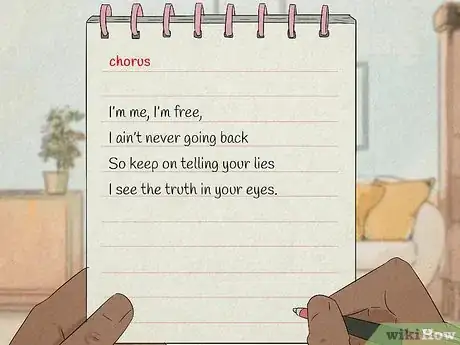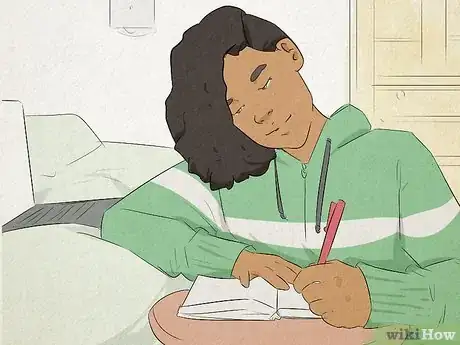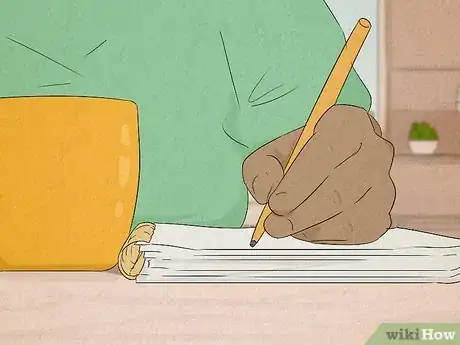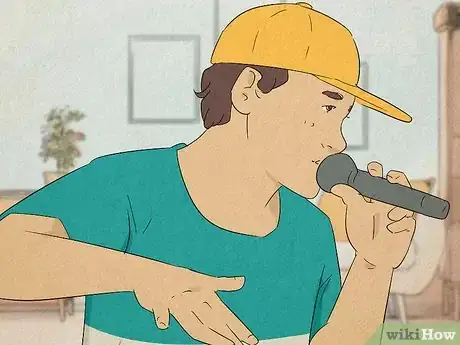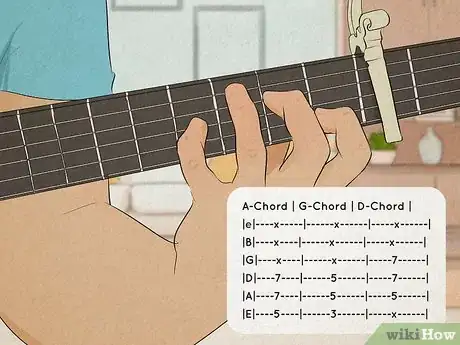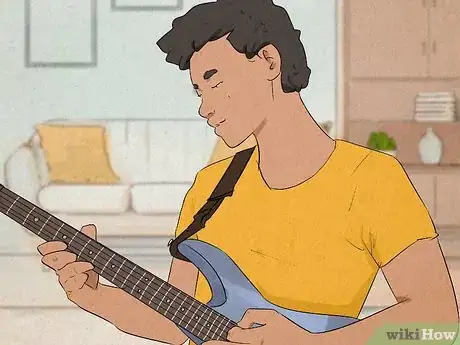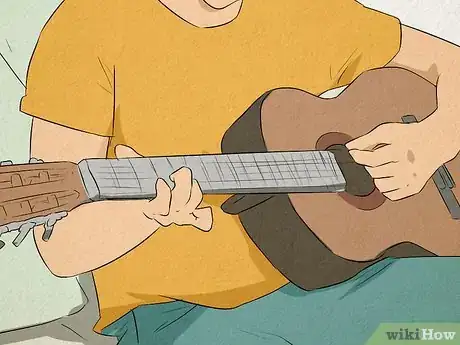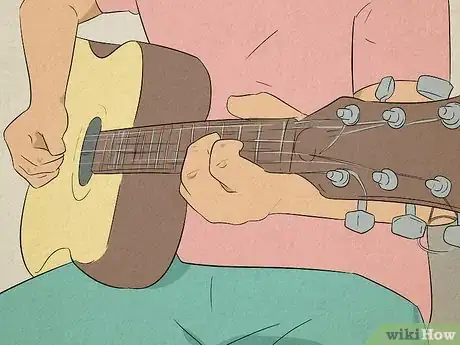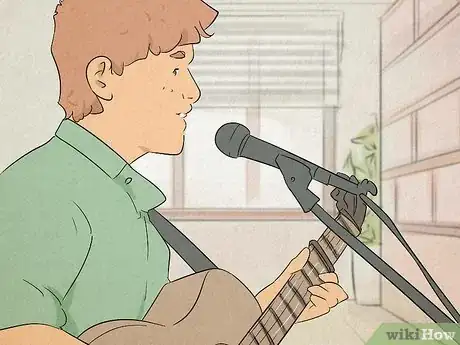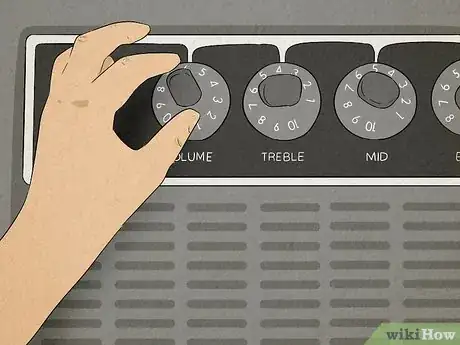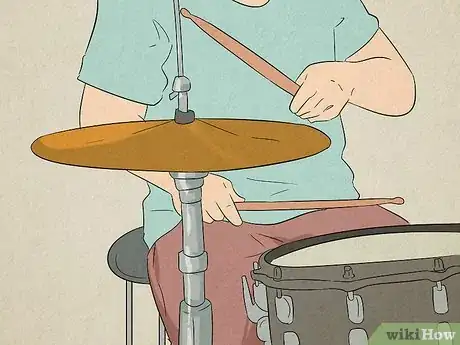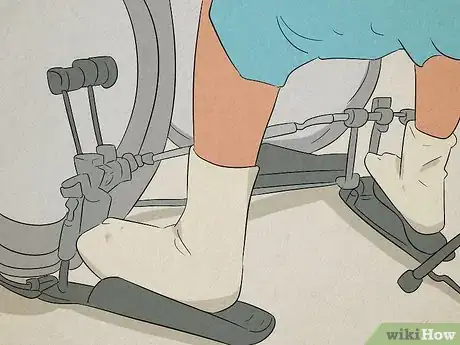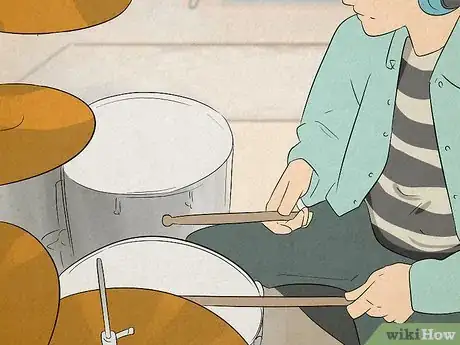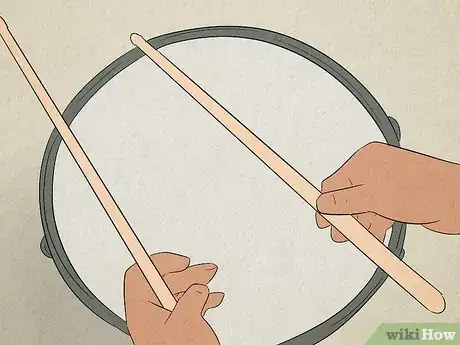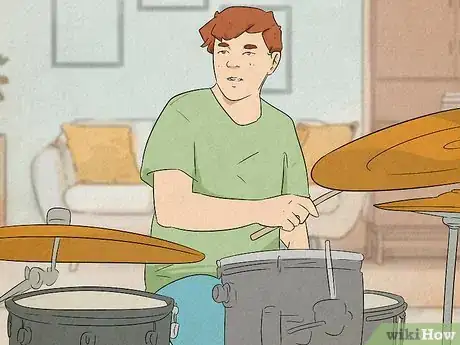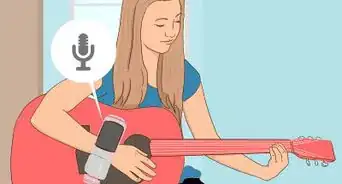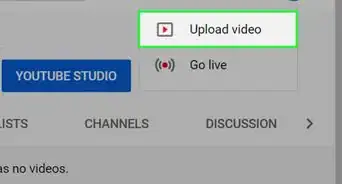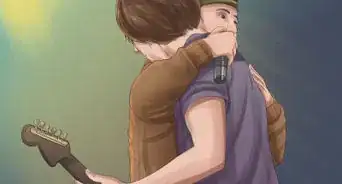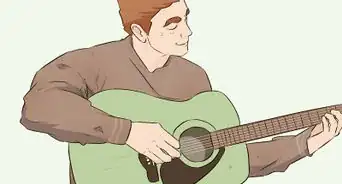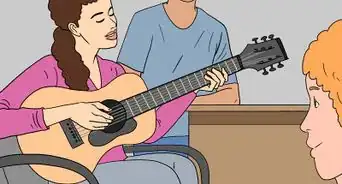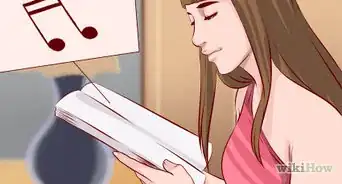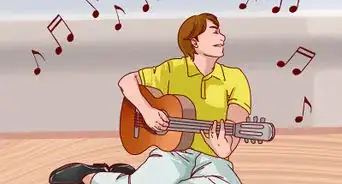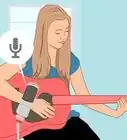This article was co-authored by Tanisha Hall. Tanisha Hall is a Vocal Coach and the Founder and Executive Director of White Hall Arts Academy, Inc. an organization based in Los Angeles, California that offers a multi-level curriculum focused on fundamental skills, technique, composition, theory, artistry, and performance at a conservatory level. Ms. Hall's current and previous students include Galimatias, Sanai Victoria, Ant Clemons, and Paloma Ford. She earned a BA in Music from the Berklee College of Music in 1998 and was a recipient of the Music Business Management Achievement Award.
There are 9 references cited in this article, which can be found at the bottom of the page.
This article has been viewed 69,327 times.
Do you idolize bands like The Clash, the Sex Pistols, and The Ramones? Brash melodies and fast, loud guitars are the hallmarks of punk, but that doesn't mean that the genre is easy. Punk isn't about sounding the most technical or skilled, but is about expressing yourself with hard, fast, melodic music and lyrics straight from the heart.
Steps
Writing Punk Lyrics
-
1Express yourself in simple, message-filled lyrics. Yell about the government, yell about your ex-girlfriend, yell about the jerk in 2B who tells you to shut up at 3:30 in the afternoon. Punk is a raw, angry, and assertive art form, meaning you don't have to worry about hiding your intent or coming up with perfect expressions. What want is to be honest and straightforward -- wear your beliefs proudly on your sleeves and you're already halfway there. Try out:
- Political Songs: Punk sprang up as a way for anyone to criticize the people "protecting and serving" us, calling them out on hypocrisy, lies, and selfishness.
- Social Messages: Think Americans are too lazy and need to wake up? Worried that the news is lying to us about war? What about disappearing jobs for working class people? The world around you is filled with injustices someone needs to shine a light on.
- Songs Fighting Authority: This authority might be your parents, a teacher, the PTA, or your boring suburban neighborhood. Punk songs assert your voice where no one else will listen to it.
- Character Songs: Punk has a long history of taking the perspective of those who can't be heard on their own, where the singer's "I" is someone very different from the actual singer. Who's story do you believe needs to be told?
- Life Stories: Not all songs need huge, deep meanings. Just as many recount incredible concert experiences, a strange day in Olympia, WA, or the fact that "Jeff Don't Wear Regular Shoes."
-
2Wield satire, sarcasm, and parody like a sharpened sword. Punk is youthful and angry, and thus it's no surprise that it can often be very funny as well. Don't be afraid to throw a little sarcasm into the songs, particularly those about social and political issues. From "Franco Un-American" to "Kill the Poor," punk often uses abrasive, difficult language and humor to point out the underlying tragedies or issues that everyone else is ignoring.
- "Kill the Poor" is an incredible example of "agreeing" with a horrible idea to show just how horrible it really is -- Jello Biafra (singer/songwriter) is one of the punk's master of satirical lyrics.
Advertisement -
3Start singing once you've established the guitar part. Joe Strummer, guitarist and lead singer of The Clash ("The Only Band that Mattered"), infamously had little more than a 3-note vocal range. Yet he realized the lyrics themselves, and the energy needed to sing them, were more important than traditionally great vocal skills. Once you've locked down some of the instrumentals, start experimenting with ways to push the lyrics alongside them. Some good ideas include:
- Using volume effectively: Every singer, no matter their talent, can use this trick. Much like a roller coaster, use your singing volume to create tension and excitement, slowing/quieting down to build suspense and then rising to a yell to drive home intense moments.
- Getting a little weird: From Jello Biafra through underground rapper Danny Brown, counter-culture singers aren't afraid to try a strange or off-kilter voice to make a point.
- Learning to scream-sing: All of the intense, almost inhuman singing in punk and hardcore may seem like it will shred your vocal chords, but there are actually safe ways to practice this distinctive tone.
-
4Don't neglect background harmonies, especially in the chorus. This circles back to the communal nature of punk, and it's not uncommon to see every member of the band contributing some vocals at some point in the songs. These can be anything from simply repeating the words the lead singer uses to adding "woooaahhsss," "ahhhhsss," or "oi oi ois!" throughout the chorus.
- Check The Clash, specifically London Calling, for masterclasses in punk backing vocals. Even the Sex Pistols, with their famously bad singing, can be seen showing off solid background vocals in "Holidays in the Sun."
-
5Aim for a catchy, easy to follow chorus that people can join along with. Punk is a communal art form, best experienced live and with an excitable audience. A catchy chorus line, especially one people can get involved in, will up the energy exponentially and turn live shows into the raucous, high-energy events they are meant to be.
- Consider small sing-along or call and response sections to get people singing.
- Not every song needs to involve the audience -- if you want a hard, fast, and barely intelligible chorus, go for it.
-
6Write either the lyrics or the instrumentals first -- there is no "right" way to get started. Every songwriter thinks differently, so don't get frozen up believing one or the other must come first. Sometimes you'll be playing along on the guitar and a song will just hit you. Other times a snippet of lyrics will hit your head and force its way out. Punk is about you being yourself, not checking off boxes or following a formula. Whatever you want to put in a song, however you want to put it there, is probably going to work in a punk rock song.
- Most songwriters keep a dedicated notebook or phone note on them at all times -- you never know when an idea will hit you.
- If you're stuck and unsure just want to write, simply start freewriting. It doesn't even have to rhyme. You'll be surprised how, eventually, a song idea crops up.
-
7Break any and all rules, fashioning songs how you want them. Punk is about individuality, not about sticking to any scripture. If you want to write a 10-minute punk epic about environmental pollution, all without a recognizable chorus, then go for it. If you want to write 20-second songs about Martians invading earth, there is nothing stopping you (and you wouldn't actually be the first punks to do so). Punk is about doing it all yourself -- so go do it yourself.[1]
Writing Punk Guitar Lines
-
1Make guitar-driven power chords the backbone of every punk song. Power chords are one of the reasons punk rock is even possible. They are easy to finger and sound great at high volumes, which makes them easily played at top speed as well. Power chords are only three notes. First, you place your index finger on the E or A string, which tells you which chord you're playing (start on a "B," and the chord is a B). You then hold the next two strings two frets down -- and that's it. For a few examples, see an A, G, and D below, but know that this form can move anywhere on the top two strings:
- A-Chord | G-Chord | D-Chord |
- |e|----x-----|------x------|-----x------|
- |B|----x----|------x------|-----x------|
- |G|----x----|------x------|-----7------|
- |D|----7----|------5------|-----7------|
- |A|----7----|------5------|-----5------|
- |E|----5----|------3------|-----x------|
-
2Know that one good, repeated guitar lick is all you need to start a song. Punk songs are quick and guitar-driven, usually made up of little more than 3-4 power chords. Find these few notes or power chords that you enjoy and combine them into a short little phrase you can repeat quickly. More often than not, this is all you need to write your verse or chorus. In many cases, especially with shorter songs (check The Minuteman or early Bad Religion and NOFX), this riff may be enough for an entire song.
- Start learning songs you love to get an idea for different chord progressions. Tweak, chop, and screw these patterns to start making your own songs.
-
3Re-write the guitar riff for a new chorus, giving the song two distinct parts. To be fair, a lot of punk bands play the same chords in every section, often in a different order or at a new tempo (as The Ramones so generously illustrate). Frequently, the chorus is the faster, more high-energy of the two, but there is nothing binding you from the opposite. Just as many bands, of course, write entirely new choruses -- just remember to use the same key (usually the first chord in the song) for both sections. When writing a chorus instrumental:
- Change up the mood or feel from the verse somehow -- get more intense, more melodic, faster/slower -- anything to differentiate the section from the verse.
- Try adding a 1-2 bar "bridge" into the chorus -- often a few different chords or a small solo line that signals the transition.
-
4Use single-note lines and riffs to spice things up. A single note line is when you play individual guitar notes, like you were soloing. If you have two guitarists, this will be the place the lead guitarist can shine. These lines are often the defining melody of the songs, and frequently mimic the melody or voice of the singer (or vice-versa).
- Listen to any punk band with two guitarists or more for examples of lead lines -- there are very few bands that stick to nothing but power chords for every single song.[2]
-
5Drape the edge of your picking hand on the back of the strings to palm mute. Palm muting is the chunky, heavy sounding chords in many slower punk songs, like the beginning of Pennywise's "Society." It works exactly like the name implies -- the fleshy part of your palm rests lightly on the end of the strings, preventing them from ringing out but still allowing the guitar to make a sound. Punk guitarists create tension by picking up and putting down palm muted to build volume or get a totally new tone.
- One of the most common palm muting tricks is to slowly raise your palm as you strum a chord, slowly peeling off the palm mute to bring the guitar to full volume.[3]
-
6Keep solos short and speedy. Guitar solos have their place in punk rock, but they usually don't last for more than a few bars -- 15 seconds or less. Soloing in punk is often about speed, frequently playing only 2-3 notes but playing them repeatedly. These notes, however, are run together quickly to give them staying power and drive. Other solo ideas include playing the theme or vocal line briefly, then diving off into other notes in the same scale. You can also go the opposite direction, playing only 2-3 slow notes that ring out loudly before dropping back into the high-tempo chorus.
- If you know a bit about guitar, you can usually use the pentatonic scales (both major and minor) for most punk solos.
- Whatever your soloing strategy, try to make every note count. Short and sweet is the name of the game
-
7Experiment with other punk subgenres when writing instrumentals. Straight up punk rock is not so straight up -- in a genre of non-conformists and DIY lovers, punk has taken on hundreds of unique or quirky influences. While hardcore and metal influences are perhaps the most obvious (check out The Misfits, Rise Against or F--ked Up), there are many other spins and variations that open up new songwriting avenues:
- Reggae / Ska: Most punk bands have at least a few ska-tinged tunes, but check out RX Bandits, Operation Ivy, and No Doubt.
- Pop: Pop-punk is the most common subgenre of pop, with everyone from Blink-182 to Green Day showing that slightly more catchy tunes with punk instruments are big sellers.
- Alt-Country: It sounds completely anti-punk, but Social Distortion, Lucero, and Uncle Tupelo all bring some deep south sound to their songs
- Swing/Rockabilly: The Dead Kennedys might have kicked it off with "Viva Las Vegas," but The Misfits and Cobra Skulls are keeping it alive.
Writing Punk Basslines
-
1Start by simply following the chords the guitarist is using. This is the easiest way to start playing effective punk bass without having to learn too much about the bass. Simply follow (or ask) the power chords that the guitarist is using. Note the root note, or where their index finger is, and play this note. Using a pick, strum this note quickly, in time with the strumming of the guitarist. It isn't a particularly unique or flashy bass line, but it will more than suffice for most punk songs.
- Rancid's "Olympia, WA" is a good example of straight 16th notes carrying the song through.
- Remember that, above all, energy is key to great punk. Really drive into the groove of the song and hit those notes in time with the guitarists for irresistibly high-tempo punk.
-
2Use the other notes in the power chords to form little riffs. You have all of the same strings and frets a guitarist needs for power chords on your 4-string bass. A good example is Green Day's "J.A.R," which opens with a bass-only riff that basically mimics the power chords in the actual song, through with a few extra flourishes. Any notes that are in the same scale or power chords are fair game for the bass to play as well, even if they aren't the root notes. This is where experimentation will do you wonders. Let your guitarist play themselves ragged while you noodle around on the bass, figuring out which notes sound the best.
- Try moving the same bass riff with each chord. For example, you might play the three notes in the first power chord before the chord shifts. Instead of making up a new riff, play the same exact "shape" of notes, just starting it on the new power chord this time.
-
3Keep the baseline moving to give the song drive and power. One of the few things binding most punk bass together is the need to keep the song moving. The bass provides the almost subconsciousness groove of the song, and thus a static, plodding bass line will slow down a song even if you can't quite hear why. A moving bass line is one that keeps your fingers dancing on the fretboard. This doesn't mean it is intensely difficult or speedy -- you just have a regular pattern keeps the song rolling.
- While not a punk song, the guitar and bassline from the Stray Cats' "Rock This Town" is a good, simple way to see how a moving bassline can keep a song moving.
- You want, at a minimum, one bass note per chord change.
- Check out "Maxwell Murder," which also features a blistering bass solo, for a good punk example of a moving bass line.
-
4Vary your picking style for different effects and sounds. Most punk bassists use picks instead of their fingers because picks have a sharper, harder sound. Experiment with both up-and-down picking and straight picking -- do you get different sounds? In general, straight picking is a little harder and messier, while up-and-down (or "alternating" picking) provides a cleaner, smoother sound. Which songs need which kind of tone?[4]
- You want some of the thickest picks you can find, as thin picks will get bullied around by thick bass strings.
-
5Set your amp for a clean style that cuts through the distortion of the guitar. It might seem like distortion is essential for punk, but that isn't so with the bass guitar. Most punk basses have a relatively clean tone, which prevents them from muddling up the guitar sound confusingly. Listening to old punk songs, note how the bass is generally clean and noticeable if you're listening for it -- a throbbing heartbeat of the song underneath the screaming guitars and blasting drums.
- The bass is the linkage between the melody of the guitar and the rhythm of the drums. You want to sit between the two of them without overpowering either of them.
- When things are hectic, provide a simple bass "base" for the listener to grab a hold of. When the drums are locked in together you might get a little dirty or experimental with your bass lines.[5]
Writing Punk Drums
-
1Prioritize energy, speed, and power when playing punk drums -- as long as you can keep time, too. As long as you can stay in time, and keep the band in time, you should be playing with as much energy as possible. The drums are often the engine of punk bands, and if you don't show up with a full-throttle mentality it will be hard to get the band to follow you. You want to imagine yourself pushing the band just a bit faster than they are comfortable. This delicate but energetic "on the edge" play makes punk exciting.
- Push the band's tempo as high as you can without completely losing cohesion. The drummer is the entire band's metronome, and they will naturally follow your lead when setting the tempo.
- Practicing with a metronome may not feel very punk, but it is an essential way to improve speed without wildly throwing your band off time.[6]
-
2Lean on your kick, snare, and hi-hat for a basic beat that fits any punk song. This simple beat has run behind thousands of punk songs, and can be easily adapted and improvised on if you want. Start by playing the high-hat on every beat (16th notes). Then simply alternate your kick drum and snare every other beat, creating a driving "boom-snap" sound that people can't help but jump and mosh to.
- Eventually, turn the kick drum or snare into two hits per beat. Throw a tom hit in place of a snare (or along with a snare hit). This pattern is merely a dropping off point for any beat you could imagine creating.[7]
-
3Try out a double-kick pedal for your bass drum. Having two feet down on the floor greatly increases the number of notes you can play on the deep, driving bass drum. While double-pedaling takes a fair amount of practice, it literally doubles the number of notes you can hit, which helps you push the energy and tempo even faster when playing live.[8]
-
4Use big, speedy drum fills on the toms and crash cymbals to transition through the song. Heading into the chorus? Signal the change with a quick run on the toms or a hard, shattering cymbal crash. While drum solos are rare in most punk songs, drum fills are often the most flashy or showy part of any punk song, and the only real stipulation is that you come back in on time. As long as you can end the fill along with the band and keep the song moving (on tempo!), then you can feel free to have some fun on the fills.
- Listen to your favorite drum fills with a closer ear. While most of them sound big and flashy, they're likely playing fewer notes than you think.
-
5Build tension and release through a careful use of silence. While drums are the engine of the songs, they shouldn't always be running. Dropping out of a song, or sitting back with a lighter or easier rhythm, is a great way to calm the audience before a blisteringly fast or technical section. There are endless ways to do this, but some common ones include:
- Only playing the kick drum. The deep, booming bass naturally creates a dark, intense feel.
- Slow drum rolls, starting from near silence and rising to a deafening roar of drums (see "All the Small Things" by Blink 18).
- Using the cymbals/kick drum to keep time, puncturing the quiet every 4 beats with a snap of the snare or toms (see The Offspring "Americana").
-
6Mix up the verse and chorus. When writing a drum part, be sure to keep some variety within each song. This can be simple, like dropping out the cymbals in the chorus to make room for backing vocals, or a complex new part for each section of the song. The important thing to do is mix it up, creating movement through the song. Think of each part like a short story. What matters most is not technical flash but entertaining your audience. Start with a slower, more normal groove, build towards a fun and energetic climax, and then bring things to a triumphant end. It sounds overly simplistic, but this simple structure provides you endless options and ideas to make the song your own.[9]
Expert Q&A
-
QuestionHow do you write a Ramones song?
 Tanisha HallTanisha Hall is a Vocal Coach and the Founder and Executive Director of White Hall Arts Academy, Inc. an organization based in Los Angeles, California that offers a multi-level curriculum focused on fundamental skills, technique, composition, theory, artistry, and performance at a conservatory level. Ms. Hall's current and previous students include Galimatias, Sanai Victoria, Ant Clemons, and Paloma Ford. She earned a BA in Music from the Berklee College of Music in 1998 and was a recipient of the Music Business Management Achievement Award.
Tanisha HallTanisha Hall is a Vocal Coach and the Founder and Executive Director of White Hall Arts Academy, Inc. an organization based in Los Angeles, California that offers a multi-level curriculum focused on fundamental skills, technique, composition, theory, artistry, and performance at a conservatory level. Ms. Hall's current and previous students include Galimatias, Sanai Victoria, Ant Clemons, and Paloma Ford. She earned a BA in Music from the Berklee College of Music in 1998 and was a recipient of the Music Business Management Achievement Award.
Vocal Coach If you want to write a song like the Ramones, listen to the Ramones! Study the song structure, lyrics, and chords. Sing along, or listen to karaoke versions of their songs and sing along to try and replicate what they're doing on their songs. This will help you internalize what the Ramones are doing in their music, which will help you replicate their style and technique with your own work.
If you want to write a song like the Ramones, listen to the Ramones! Study the song structure, lyrics, and chords. Sing along, or listen to karaoke versions of their songs and sing along to try and replicate what they're doing on their songs. This will help you internalize what the Ramones are doing in their music, which will help you replicate their style and technique with your own work. -
QuestionCan a punk band have just a guitar and a singer?
 Community AnswerPunk is whatever you want it to be -- you fighting authority, not bowing to it. Check out Billy Bragg for a good example of a guitar and voice doing something other than folk.
Community AnswerPunk is whatever you want it to be -- you fighting authority, not bowing to it. Check out Billy Bragg for a good example of a guitar and voice doing something other than folk. -
QuestionCan I mix a ska-style song with a metal riff?
 Community AnswerThis can turn out very successfully with the right song. There are many songs that crossover or combine two different musical styles, such as alt-rock, country-rock, or jazz fusion.
Community AnswerThis can turn out very successfully with the right song. There are many songs that crossover or combine two different musical styles, such as alt-rock, country-rock, or jazz fusion.
Warnings
- Remember it doesn't take much technical or classical "skill" to play punk, but it does take dedication and energy. Just because it is technically simple doesn't mean it is easy.⧼thumbs_response⧽
References
- ↑ https://www.ultimate-guitar.com/forum/showthread.php?t=887155
- ↑ http://www2.fender.com/experience/fender-tone/play-punk-power-chords-palm-muting/
- ↑ http://www2.fender.com/experience/fender-tone/play-punk-power-chords-palm-muting/
- ↑ http://www.gibson.com/News-Lifestyle/Features/en-us/The-Art-Of-Punk-Bass.aspx
- ↑ http://www.bassplayer.com/artists/1171/econo-101-mike-watts-school-of-punk-rock/26964
- ↑ http://www.rockdrummingsystem.com/underground/drum-beats/punk-rock-drumming.php
- ↑ http://www.drumlessons.com/drum-lessons/rock-drumming/beginner-punk-rock-drum-beats/
- ↑ http://www.rockdrummingsystem.com/underground/drum-beats/punk-rock-drumming.php
- ↑ http://www.drumlessons.com/drum-lessons/rock-drumming/intermediate-punk-rock-drum-beats/



